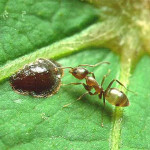
How to get rid of this?.To get rid of pest problem under control, inspection is the first and foremost step.
The Argentine ant, Linepithema humile (formerly Iridomyrmex humilis), is an ant native to northern Argentina, Uruguay, Paraguay, and southern Brazil. It is an invasive species that has been established in many Mediterranean climate areas, inadvertently introduced by humans to many places, including South Africa, New Zealand, Japan, Easter Island, Australia, Hawaii, Europe, and the United States.
Description
The worker ants are 1.6–2.8 millimeters (0.063–0.110 in) long and can easily squeeze through cracks and holes as small as 1 millimeter (0.039 in) in size. Queens are 4.2–6.4 millimeters (0.17–0.25 in) long, much smaller than other species of ants.
Typical size of worker ants found in Southern California.
These ants will set up quarters in the ground, in cracks in concrete walls, in spaces between boards and timbers, even among belongings in human dwellings. In natural areas, they generally nest shallowly in loose leaf litter or beneath small stones, due to their poor ability to dig deeper nests. However, if a deeper nesting ant species abandons their nest, Argentine ant colonies will readily take over the space. German entomologist Gustav L. Mayr identified the first specimens of Hypoclinea humilis in the vicinity of Buenos Aires, Argentina in 1866. This species was shortly transferred to the genus Iridomyrmex, and finally to Linepithema in the early 1990s. The Argentine Ant is often confused with a related ant species, the Pharaoh Ant (Monomorium pharaonis).
